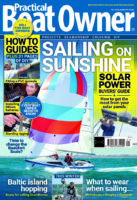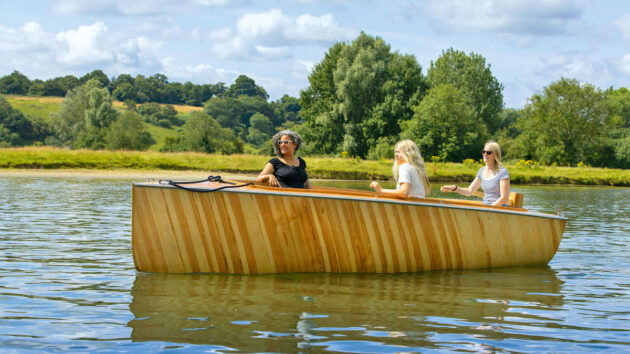Annie Means talks to the founders of BlueTree about their innovative approach to boatbuilding design and construction
The term maritime innovation usually brings to mind bustling ports, sprawling factories, and urban coastal cities, rarely a quaint seaside town, writes Annie Means.
Yet, nestled among the rolling cliffs of Lyme Regis, a small startup is quietly challenging ‘business as usual’ in the leisure marine industry, putting sustainability at the company’s heart.
“What we’re trying to do is not only push sustainability, but also push what’s possible,” says Otto Marples of BlueTree Boatbuilders.
Marples and his co-founder, Obioma Oji, met at the Lyme Regis Boat Building Academy during their boatbuilding course.
They came from different backgrounds — Otto, rooted in marketing and operations, Obi, in design and academia.
On paper, the two might have seemed an unlikely team. But they quickly became friends and launched their eco-conscious marine startup.
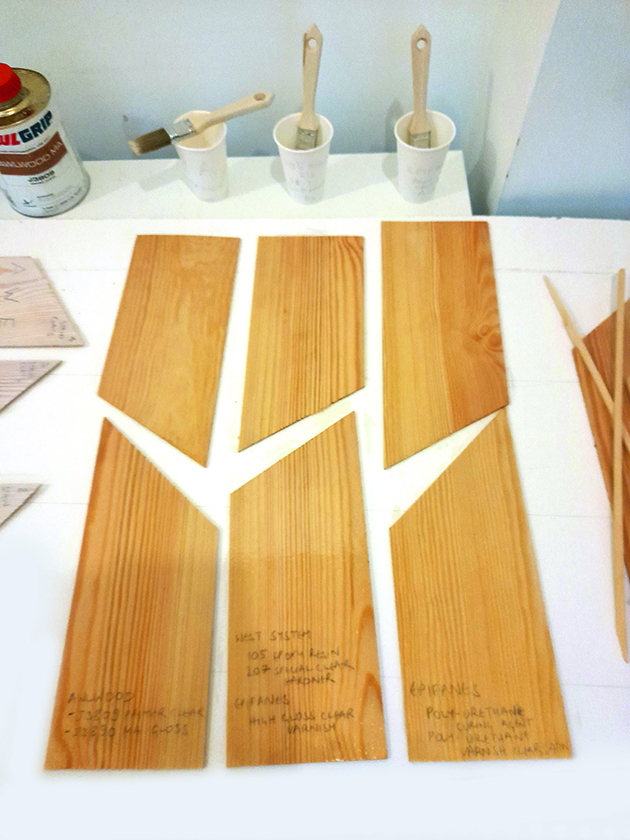
All material is researched and tested to ensure it meets BlueTree’s high sustainability goals. Credit: BlueTree
Now, three years in, Marples and Oji have unveiled Stria 5: their company’s first boat, built with a deliberately progressive approach to construction and stewardship.
The Stria is a 5m vessel made from Vendia marine plywood, oak, and Douglas fir.
It’s powered by two high-performance 3,500Wh lithium batteries and a Torqeedo Cruise 3.0 pod drive—underscoring BlueTree’s steadfast avoidance of non-biodegradable glass-reinforced plastic (GRP) and fuel-guzzling outboards.
Oji and Marples describe their business as a progressive boatbuilding company, rather than pioneering; for example, resin is still used, but it’s Entropy, a bio-based epoxy resin that utilises plant-based ingredients not petroleum-derived ones.
All business decisions aim to bring balance between the natural world and the leisure marine industry, from sourcing materials and cultivating workplace culture to reducing delivery emissions and considering the impact their boats have on the community.
Following the build of the Stria offers a clearer picture of how principles, research, and follow-through come together to create a model and culture aimed at a more ethical future.
BlueTree ethos: research lab
Each build passes through four key phases: the research lab, construction, fit-out, and finishing. The research lab is where ideas are generated and tested, from selecting designs in collaboration with naval architects to sourcing materials and planning each stage of the build.
At each stage, Marples and Oji ask: What do we actually need, and what’s the most sustainable version that we can get now?
MarineShift360’s Life Cycle Assessment (LCA) tool is also used to evaluate the environmental impact of their material choices.

A Torqeedo Cruise 3.0 pod drive powers Stria. Credit: BlueTree
The software tracks a boat’s footprint from raw material to disposal, offering a clearer view of its working (and eventually retired) life.
Stria was the first boat BlueTree put through the system, which now guides their approach.
The LCA and this research strategy align with the principles of a circular economy – an economic model that seeks to minimise waste and make the most of resources by designing products for durability, reuse, and recyclability, all while fostering environmental regeneration.
Due to the difficulty in recycling end-of-life GRP, and the environmental damage caused by abandoned GRP vessels, BlueTree builds only from wood.
“For me, it’s more natural,” said Oji. “Wood is fixable and maintainable – you can bring it back to life. On the plastic side, it’s good for a time, but then it just fails.”
Design
Stria was designed in collaboration with naval architect Ben Rogerson. “It was inspired by classically planked fore-and-aft river launches, but with a key departure; this one is clearly cold-moulded,” explained Oji.
Cold-moulding is the process of laminating multiple thin layers of wood veneers (usually with epoxy resin) to form the hull.
Each layer is applied at a different angle to increase strength and durability, resulting in a lightweight yet remarkably strong structure.
Construction: the BlueTree way
Like many boats, Stria began her life upside down. The team first created a jig (a full-scale prototype used as a shaping tool for the hull) to build a strip-planked plug from tulipwood.
Alongside the plug-making, BlueTree crafted the centreline components (hog, transom, stern knee, and stem), which were faired on the plug before removing it and prepping the plug for hull construction.
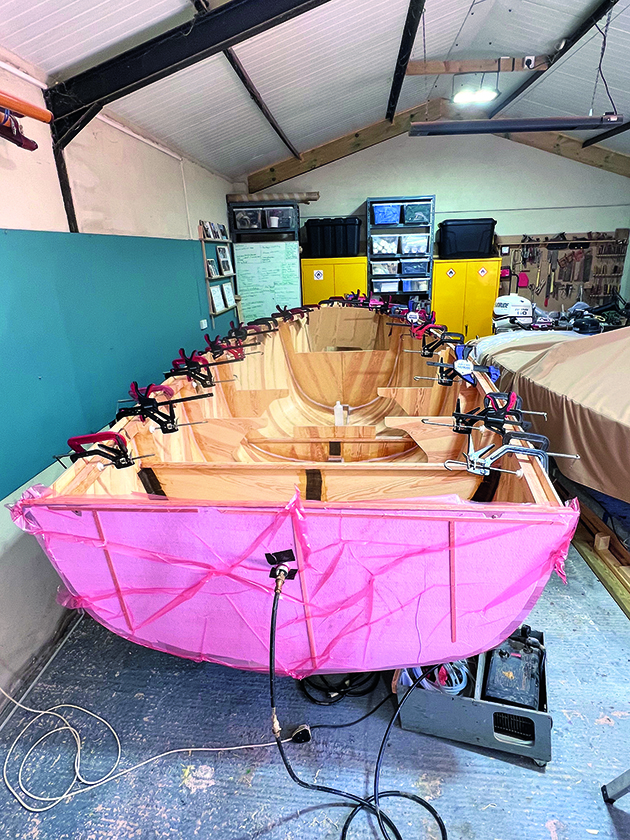
6mm oak was vacuumed onto the boat’s transom. Credit: Bluetree
The centreline was made from oak, except for the transom, which was made of 24mm Vendia.
Later in the process, 6mm oak was vacuumed onto the transom to protect the end grain of the cold-moulded layers.
That structure served as the foundation for laying three layers of wood crafted from one of the most sustainable materials on the market: Vendia marine ply.
Cold moulding the hull
Initially, the choice for Stria’s hull came down to two materials: UK-grown sweet chestnut and Vendia marine ply, a laminated wood product made from slow-grown, plentiful Nordic pine, prized for its strength, light weight, and traceable supply chain; it can be traced back to a specific tree.
When laying the Vendia veneers, BlueTree opted for a diagonal pattern, a design choice that reflects their willingness to experiment.
“From a cost point of view, we went with Vendia. It’s obviously a marine-grade plywood. But we didn’t know how it would perform. It hadn’t been done at that scale before,” said Oji.

The second layer of the cold moulded hull. Credit: BlueTree
Here’s where the ‘progressive’ part of BlueTree comes into play – not just in making sustainable choices, but in pushing the envelope of what’s considered standard in boatbuilding.
At the time Stria was built, it was the largest vessel ever constructed using Vendia marine ply.
Until then, it had mostly been used for paddleboards, canoes, and smaller watercraft.
BlueTree is also exploring alternatives to traditional glassfibre construction.
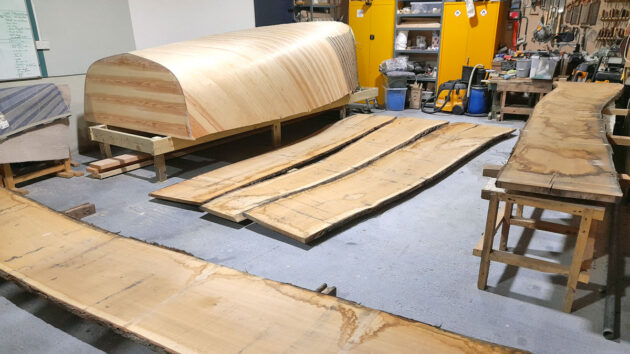
Stria’s keel was made of oak before flax was used for reinforcing. Credit: BlueTree
Instead, natural fibre composites, primarily flax which is biodegradable and renewable, are used in their cold-moulded hulls.
Around Stria’s oak keel, flax reinforcement adds strength.
Epoxy resins, which contain Bisphenol A (BPA) – a substance classified by the European Environment Agency as harmful to humans and an endocrine disruptor – are also avoided.
Instead, BlueTree uses Entropy’s clear laminating epoxy, a resin that incorporates up to 29% of bio-based content.
Framing
Once Stria was turned over, frames were installed. Made from Vendia, the frames were 12mm in thickness and precision-cut using a CNC machine.
After some shaping, the frames were glued into place, and flax was used to strengthen the boat’s bulkheads.
Fit-out
Next was the fit-out of the vessel, starting with Stria’s propulsion system.
Staying true to BlueTree’s commitment to moving beyond diesel and fossil fuels, Marples and Oji chose a Torqeedo Cruise 3.0 pod drive.

The vertical design of the benches means less structure underneath, allowing more storage space. Credit: BlueTree
The fit-out included templating, shaping the coaming, installing custom lockers and a battery box lid, and crafting the benches.
“The benches are really cool. That was obviously Obi’s favourite– she’s big into chairs,” said Marples, highlighting Oji’s previous life as an IKEA designer.
“If these were horizontal, you’d need a lot of structure beneath them. But these are vertical,” added Oji.
Finishing
To align with BlueTree’s environmental goals, Marples and Oji chose Awlwood, a streamlined, single-system primer and varnish.
Traditionally, wooden boats have a reputation for being maintenance-heavy, especially when it comes to finishing.
That upkeep – laborious and time-consuming –often nudges boat owners toward GRP alternatives.
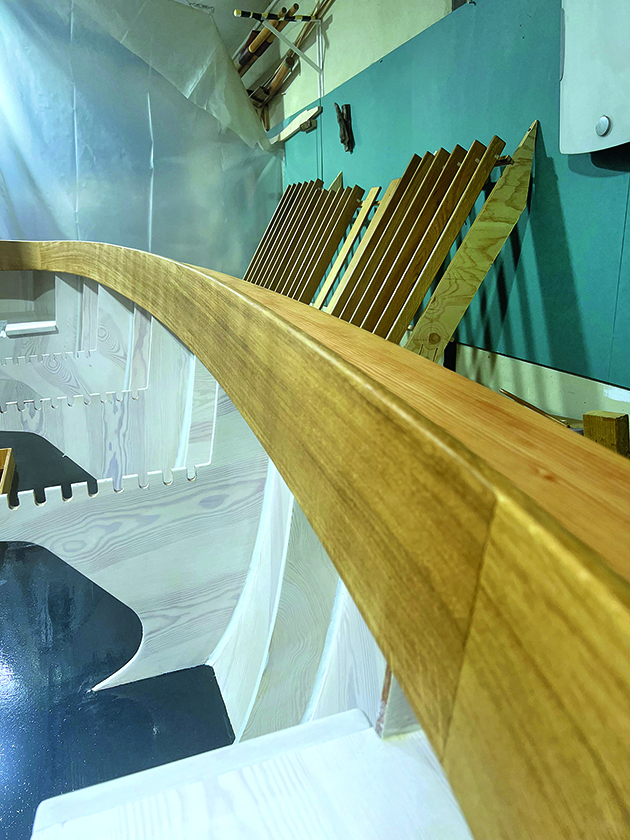
Awlwood was used on the woodwork, while the interior woods were whitewashed to preserve the wood grain. Credit: BlueTree
Aware of this bias, the BlueTree team opted for a finish that would demand less over time without compromising performance or appearance.
Everything was tested in the research lab before committing – no surprises, no mismatched tones.
“In the marine world, people are often resistant to light-coloured boats,” Oji said. “You understand where it comes from. Darker timbers seem more durable, even though plenty of light ones are just as durable.”
They varnished both the interior and exterior of the boat. In contrast to many wooden boats, the interior was whitewashed rather than painted to highlight the grain.
Beyond the boat
Marples and Oji care not just about the life cycle analysis of their vessels but also about the sustainability of every fitting and accessory that comes with them.
There’s an old saying about boats – ‘Bring Out Another Thousand’—which reminds us all that a vessel is more than just its hull.
It’s the sum of all its parts, literally and financially.
“We were trying to find boat covers that were sustainable. But there aren’t many options out there that last long or stand up to UV damage,” said Oji.
Dissatisfied with what the market offered, BlueTree teamed up with Arts University Bournemouth to explore new ways to create UV-resistant covers using more eco-conscious materials.
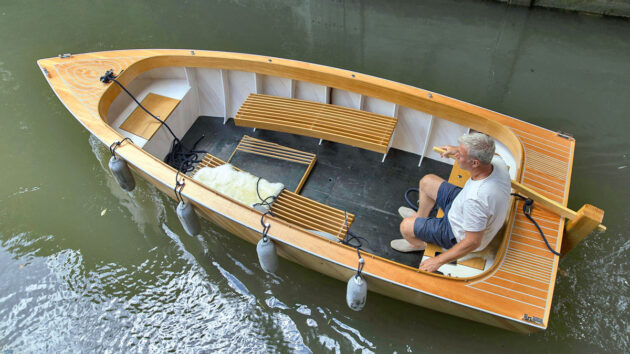
The building of Stira has been documented and shared to try and help move boatbuilding towards greater sustainability. Credit: BlueTree
In many ways, BlueTree’s insistence on collaborative innovation pushes not only their own company but also a wider network of makers and thinkers to put the environment front and centre.
“We back everything with research,” Oji explained.
Documenting Stria’s build and performance, partnering with universities, and showcasing their work at design conferences and in journals means Marples and Oji are educating consumers in multiple ways and helping shift the entire industry toward sustainability.
The journey to building their first Stria took time. Marples and Oji wanted more than just a boat.
They wanted a day launch that could serve as a proving ground for their progressive ideals – a space to test new materials for durability and performance, experiment with innovative production methods, refine their manufacturing process, and trial design features and system integration, all while laying the groundwork for their business.
Now with the boat in the water and connections among partners growing, BlueTree’s progressive approach to building appears to be a success, one that Marples and Oji hope will inspire other companies to follow suit and question just how expansive the future of green maritime innovation can be, even if it starts in a small country barn.
Restoring Tethra: how a Looe fishing boat became a dining sensation
Annie Means talks to the owners and restorers of a Cornish motor luanch which is now used for dining afloat
A sustainable alternative to marine ply?
Even the best marine ply is not totally moisture resistant and will eventually succumb to rot after extended periods of…
How to choose the right electric boat engine
Electric propulsion is clean, near silent and can even be self-refuelling, but is it worth the investment? Jake Kavanagh considers…
Electric engine conversion on a Contessa 32
Norman Rubenis gets ‘Thunderstruck’ when he ditches the diesel and converts his Contessa 32 to run on a 10kW electric
Want to read more boat articles?
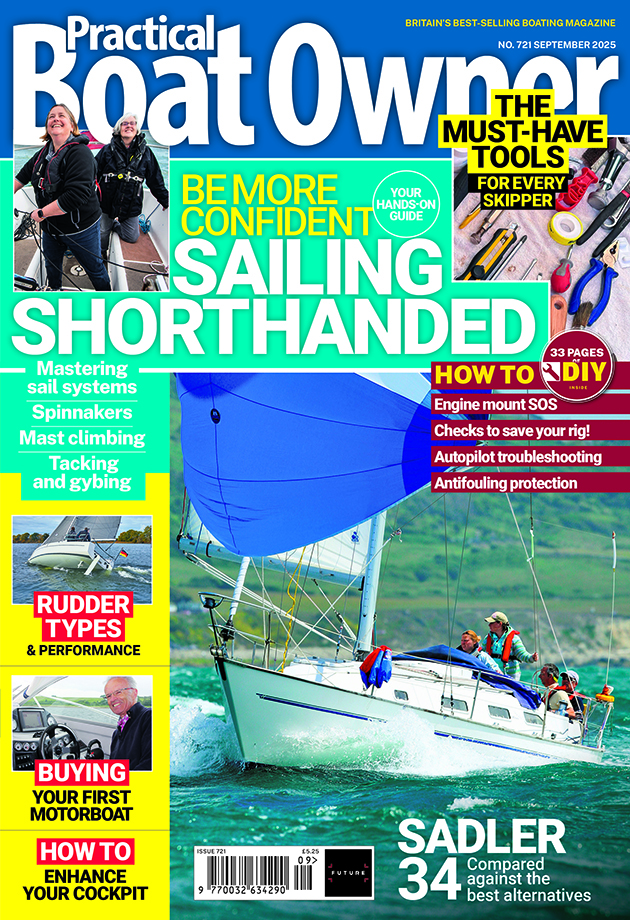
A subscription to Practical Boat Owner magazine costs around 40% less than the cover price.
Print and digital editions are available through Magazines Direct – where you can also find the latest deals.
PBO is packed with information to help you get the most from boat ownership – whether sail or power.
-
-
-
- Take your DIY skills to the next level with trusted advice on boat maintenance and repairs
- Impartial, in-depth gear reviews
- Practical cruising tips for making the most of your time afloat
-
-
Follow us on Facebook, Instagram, TikTok and Twitter

